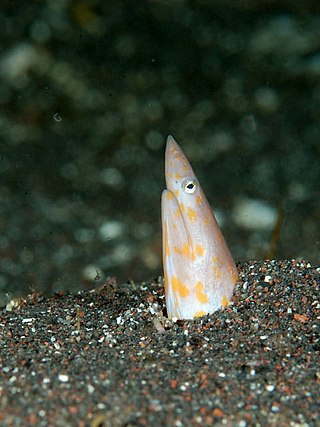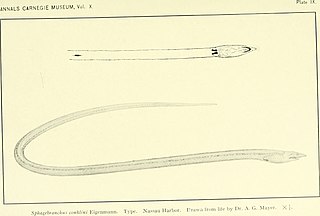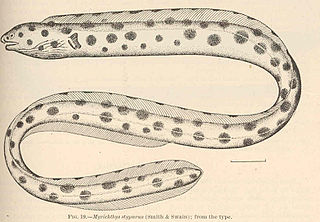
Leiuranus is a genus of eels in the snake eel family Ophichthidae. It currently contains the following species:
The Fringe-lipped worm-eel is an eel in the family Ophichthidae. It was described by Henry Weed Fowler in 1934. It is a marine, tropical eel which is known from the western central Pacific Ocean, including Taratara Island, Samar Island, the Philippines, the Marshall Islands, Micronesia and Solomon Island. It dwells at a maximum depth of 48 metres (157 ft), and inhabits benthic sand sediments in coral reefs. Males can reach a maximum total length of 11.5 centimetres (4.5 in).
The redfin worm-eel is an eel in the family Ophichthidae. It was described by James Douglas Ogilby in 1897, originally under the genus Myropterura. It is a marine, tropical eel which is known from the Indo-Pacific and southeastern Atlantic Ocean, including the Red Sea, East and South Africa, Ducie Island, and Lord Howe Island. It dwells at a depth range of 1 to 26 metres, and inhabits lagoons and reefs, forming colonies in sand sediments in confined areas. Males can reach a maximum total length of 35 centimetres (14 in).

The sharpsnout snake eel is an eel in the family Ophichthidae. It was described by Max Carl Wilhelm Weber in 1913. It is a marine, tropical eel which is known from the Indo-Western Pacific, including East Africa, the Marshall Islands, and the Hawaiian Islands. It dwells at a depth range of 10 to 25 metres, and lives in congregations in confined regions of sand sediments. Males can reach a maximum total length of 40 centimetres (16 in).

The crocodile snake eel is an eel in the family Ophichthidae. It was described by Edward Turner Bennett in 1833. It is a tropical, marine eel which is known from the Indo-Pacific, including East Africa, the Society Islands, Japan, and Australia. Males can reach a maximum total length of 120 centimetres. It dwells at a depth range of 0–30 metres, and inhabits coral reefs. It forms burrows in sand and lies in wait to ambush prey, leaving only its eyes exposed. Its diet consists of octopuses, species of Calcarina, and finfish.

Callechelys lutea, the freckled snake eel or yellow-spotted snake eel, is an eel in the family Ophichthidae. It was described by John Otterbein Snyder in 1904.

The Surf eel is an eel in the family Ophichthidae. It was described by Barton Warren Evermann and Millard Caleb Marsh in 1900, originally under the genus Sphagebranchus. It is a marine, tropical eel which is known from the western and eastern Atlantic Ocean, including Bermuda, the Bahamas, Florida, USA; Puerto Rico, the Virgin Islands, northern South America, and St. Helena Island. It dwells at a maximum depth of 35 metres (115 ft), most often between 5 to 15 metres, and forms burrows in sand bottoms in surf areas, from which its common name is derived. Males can reach a maximum total length of 45 centimetres (18 in).
The Oriental worm-eel, also known as the Oriental snake eel, the Oriental sand-eel or the finny sand-eel, is an eel in the family Ophichthidae. It was described by John McClelland in 1844, originally under the genus Dalophis. It is a tropical, marine and freshwater-dwelling eel which is known from the Indo-Western Pacific, including Somalia, South Africa, India, Papua New Guinea, Tahiti, French Polynesia, Indonesia, Oman, Palau, New Caledonia, the Philippines, Sri Lanka, Seychelles, and Vanuatu. It dwells at a depth range of 0 to 3 metres, and forms burrows in sand and mud sediments in estuaries, rivers, and inshore turbid waters. Males can reach a maximum total length of 36 centimetres (14 in), but more commonly reach a TL of 25 centimetres (9.8 in).
The Convict snake eel is an eel in the family Ophichthidae. It was described by John Richardson in 1848. It is a tropical, marine eel which is known from the Pacific Ocean, including Palau, Australia, Papua New Guinea, and Norfolk Island. It dwells at a depth range of 3–18 metres, and forms burrows in the soft bottoms of inshore regions. Males can reach a maximum total length of 75.4 centimetres.

The magnificent snake eel, also known as the Hawaiian spotted snake eel, is an eel in the family Ophichthidae. It was described by Charles Conrad Abbott in 1860, originally under the genus Pisoodonophis. It is a marine, tropical eel which is known from the eastern central Pacific Ocean, including the Hawaiian Islands, the Leeward Islands, Johnston Island, and Midway Atoll. It dwells at a depth range of 1 to 262 metres, and inhabits crevices, sand and rocks. Males can reach a maximum total length of 78 centimetres (31 in).

The Napoleon snake eel is an eel in the family Ophichthidae. It was described by Johann Jakob Kaup in 1856, originally under the genus Poecilocephalus. It is a marine, tropical eel which is known from the Indo-Pacific, including Durban, South Africa, Mauritius, Indonesia, Japan, Australia, and the Penghu Islands. It is known to dwell at a depth of 20 metres (66 ft), and inhabits lagoons and reefs; it forms solitary burrows in sand sediments. Males can reach a maximum total length of 75 centimetres (30 in).
The death-banded snake eel is an eel in the family Ophichthidae. It was described by Samuel Garman in 1899. It is a tropical, marine eel which is known from the eastern central and southeastern Pacific Ocean, including the central Gulf of California, Colombia, Costa Rica, Mexico and Panama. It dwells at a depth range of 35–760 metres, and forms burrows in sandy and muddy bottoms. Males can reach a maximum total length of 86 centimetres.

The many-eyed snake eel is a species of eel in the family Ophichthidae. It was described by Pieter Bleeker in 1864. It is a tropical, marine and freshwater-dwelling eel which is known from the Indo-Pacific, including East Africa and the Hawaiian Islands. It dwells at a depth of 2 to 25 metres, and inhabits sand and rubble sediments near coral reefs. Males can reach a total length of 62.5 centimetres (24.6 in).
The wrinkled snake eel is an eel in the family Ophichthidae. It was described by David Starr Jordan and Charles Harvey Bollman in 1890. It is a marine, tropical eel which is known from the eastern central and southeastern Pacific Ocean, including the Galapagos Islands and the Cocos Islands. It is also speculated to occur in Malpelo Island. It is known to dwell at a depth of 200 metres (660 ft), and inhabits sediments of sand and rubble. Males can reach a maximum total length of 68 centimetres (27 in).

The Pacific snake eel is an eel in the family Ophichthidae. It was described by Johann Jakob Kaup in 1856, originally under the genus Muraenopsis. It is a marine, subtropical eel which is known from the eastern central and southeastern Pacific Ocean, including California, USA, Peru, the Gulf of California, Mexico, the Galapagos Islands, Colombia, Ecuador, Costa Rica, El Salvador, Honduras, Guatemala, Nicaragua, and Panama. It dwells at a maximum depth of 155 metres (509 ft), and forms burrows in mud and sand sediments. Males can reach a maximum total length of 115 centimetres (45 in), but more commonly reach a TL of 80 centimetres (31 in).
The Pouch snake eel is an eel in the family Ophichthidae. It was described by George S. Myers and Charles Barkley Wade in 1941, originally under the genus Letharchus. It is a marine, tropical eel which is known from the eastern central and southeastern Pacific Ocean, including the Galapagos Islands, the Revillagigedo Islands, and the Cocos Islands. It is known to dwell at a maximum depth of 10 metres (33 ft), and inhabits sand sediments. Males can reach a maximum total length of 64.3 centimetres (25.3 in).
The Short-maned sand-eel is an eel in the family Ophichthidae. It was described by Geoffrey Palmer in 1970. It is a marine, tropical eel which is known from the Indo-Pacific, including the Red Sea, the Aldabra Islands, the Hawaiian Islands, and the Marquesan Islands. It is known to dwell at a depth of 60 metres (200 ft), and leads a benthic lifestyle. Males can reach a maximum total length of 59 centimetres (23 in).

The Marble-toothed snake-eel is an eel in the family Ophichthidae. It was described by Charles Henry Gilbert in 1898. It is a marine, tropical eel which is known from the eastern central and southeastern Pacific Ocean, including Costa Rica, Colombia, Panama and Ecuador. It dwells in shallow waters at a maximum depth of 10 metres (33 ft), and inhabits sand and mud sediments and mangroves. Males can reach a maximum total length of 68 centimetres (27 in).

Pisodonophis semicinctus is an eel in the family Ophichthidae. First described by John Richardson in 1848., it is a marine, subtropical eel which is known in the eastern Atlantic Ocean from Gibraltar to Angola. It was first recorded in the Mediterranean Sea in 1958 off Algeria and is now found on both shores of the western Basin. It dwells at a depth range of 10 to 30 m and inhabits the continental shelf, where it forms burrows in sand and mud. Males can reach a maximum total length of 80 cm, but more commonly reach a TL of 60 cm.

The Galapagos snake eel is an eel in the family Ophichthidae. It was described by David Starr Jordan and Charles Harvey Bollman in 1890. It is a marine, tropical eel which is known from the eastern central and southeastern Pacific Ocean, including Colombia, the Gulf of California, Costa Rica, and the Galapagos Islands in Ecuador. It dwells at a depth range of 3 to 30 metres, and inhabits reefs, preferring to live in areas bearing a mixture of boulders, gravel and sand. Males can reach a maximum total length of 71 centimetres (28 in).












